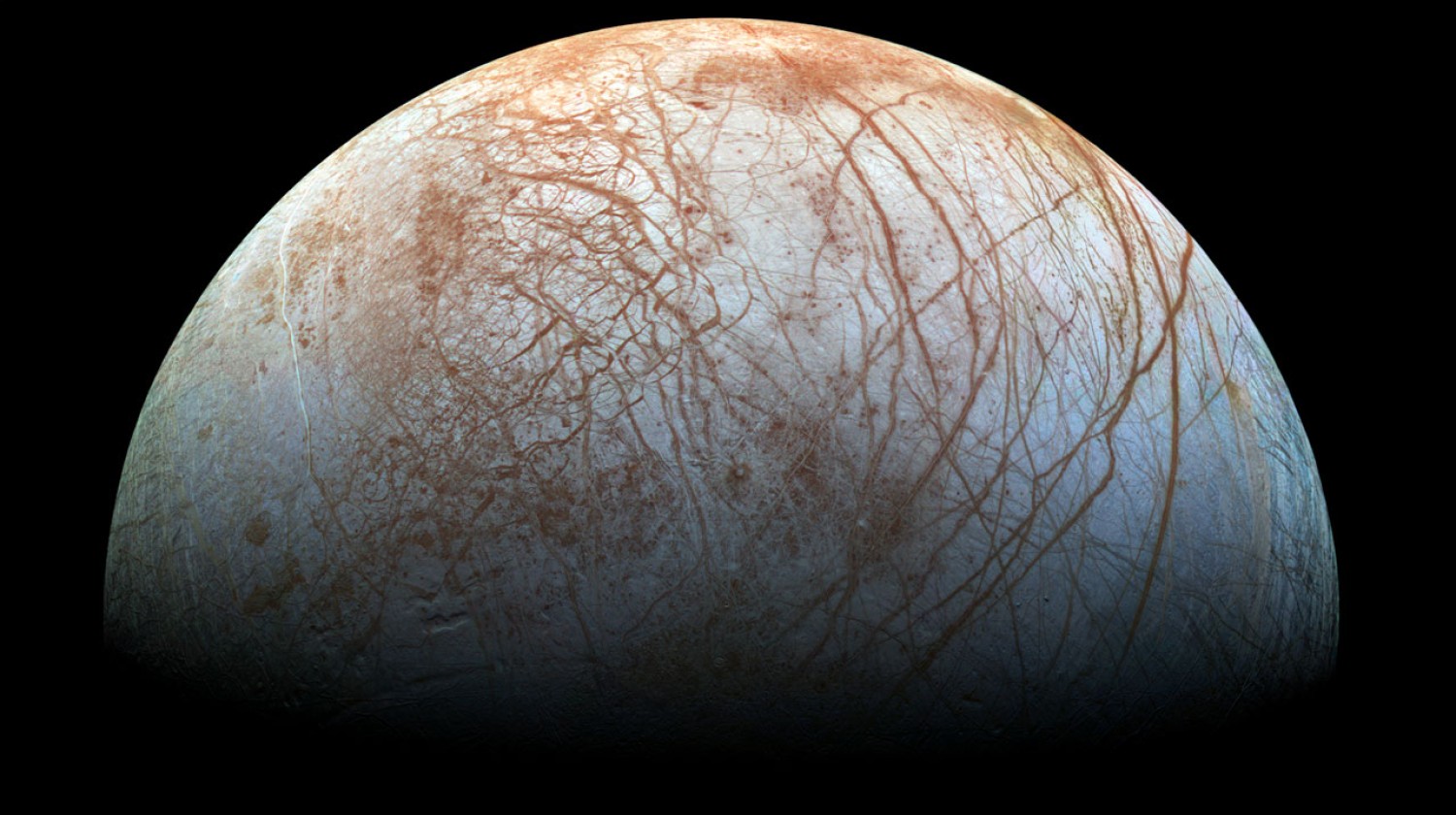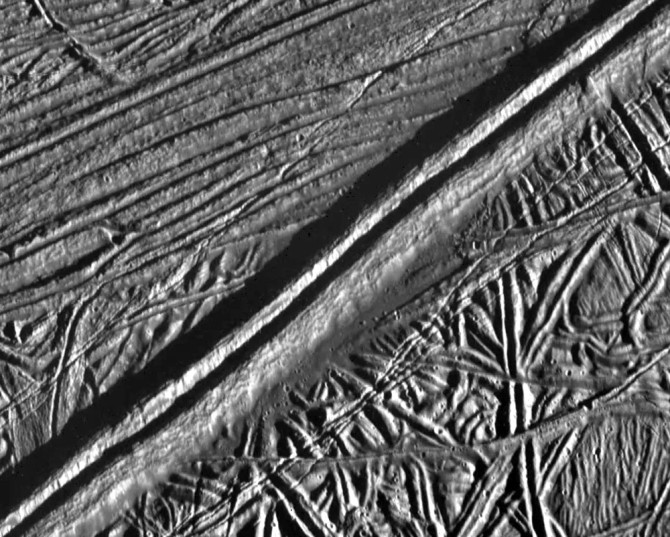
An artist's concept of NASA's Europa Clipper spacecraft.
Scientists supporting mission to assess Europa’s habitability
By James Dean, Cornell Chronicle
An outer ice shell marked by “chaos terrain,” a vast ocean, cryovolcanoes, misty plumes, gravitational tides and intense radiation.
Jupiter’s moon Europa may have them all – and potentially conditions that could support life. To find out, NASA has launched its next flagship science mission, Europa Clipper – the space agency's first dedicated spacecraft mission to study an ocean world beyond Earth – and Cornell scientists will play a role in reporting discoveries about its habitability.
The mission is managed by NASA’s Jet Propulsion Laboratory – where Jonathan Lunine, the David C. Duncan Professor in the Physical Sciences Emeritus in the College of Arts and Sciences (A&S) and a member of Europa Clipper’s gravity science team, was recently named chief scientist – in partnership with the Johns Hopkins University Applied Physics Laboratory.
Four more faculty members are part of the official teams that will analyze data from the spacecraft’s nine instruments and a gravity science experiment – investigating the moon’s interior, composition and geology – when it begins 49 planned flybys of Europa starting in 2030, research that graduate students are helping to advance.
“One of the most fundamental discoveries made in the past two decades is that the ocean worlds of the outer solar system, including Europa, are likely to contain habitable environments that can support life as we know it,” said Alex Hayes ’03, M.Eng. ’04, the Jennifer and Albert Sohn Professor of Astronomy (A&S), part of the team responsible for the mission’s high-resolution imagery. “Europa Clipper represents the first step in the path toward a direct search for life outside of Earth.”
Britney Schmidt, associate professor of astronomy and of earth and atmospheric sciences in A&S and Cornell Engineering, was involved in the mission’s early design and works with the spacecraft’s ice-penetrating radar instrument. Her Planetary Habitability and Technology Lab’s research with an underwater robot may inform eventual exploration beneath the surfaces of ocean worlds like Europa.
“This has been the top priority mission for planetary science since the early 2000s,” Schmidt said. “The science is going to be incredible.”

The puzzling, fascinating surface of Jupiter's icy moon Europa looms large in this reprocessed color view made from images taken by NASA's Galileo spacecraft in the late 1990s. This is the color view of Europa from Galileo that shows the largest portion of the moon's surface at the highest resolution.
Several of the Big Red researchers were in Florida to see the mission blast off on Oct. 14, an event delayed by Hurricane Milton. They shared some of what excites them about the mission.
Schmidt is a co-investigator on Europa Clipper’s REASON (Radar for Europa Assessment and Sounding: Ocean to Near-surface) instrument, which she said will allow scientists to see inside the moon’s ice shell for the first time and improve understanding of its “plumbing.”
“We’ll get to see the surface up close and unpuzzle the geology – which will be quite a feat given how complex Europa’s surface is,” Schmidt said. “We’ll be looking to find shallow water in the ice shell, answering where there may be habitats for life in the ice shell, as well as hopefully being able to detect the top of the ocean. We’ll also be able to measure the ice shell’s thickness using our measurements of the surface elevation, and also help find safe places to one day send a lander to look for life.”
Hayes, director of the Cornell Center for Astrophysics and Planetary Science and of the Spacecraft Planetary Image Facility, is a co-investigator for the Europa Imaging System (EIS). The pair of cameras will deliver the most detailed images yet of Europa’s surface, three orders of magnitude better than those the Galileo mission captured. Typically, Hayes said, just one order of magnitude in improvement fundamentally changes understanding of a planetary surface. Scientifically, he’s most interested in understanding how, and over what timescales, the surface communicates with Europa’s subsurface ocean.
“What really gets me excited,” Hayes said, “is the fact that upcoming missions are being designed not to just look for these places, but to directly investigate whether or not they are inhabited with a second genesis of life.”
Julie Rathbun, senior research associate in the Department of Astronomy (A&S), has co-chaired the mission’s Geology Working Group and is a co-investigator on the Europa Thermal Emission Imaging System (E-THEMIS) instrument, an infrared system that will measure how the surface retains heat and look for hot spots from venting plumes or underground lakes.
Rathbun said she’s fascinated by the geological activity on Europa, Io and Ganymede, Galilean satellites engaged in an “orbital dance” with Jupiter’s gravity that creates significant energy in their interiors. Before that “tidal heating” was understood, Rathbun said, most moons in the solar system were thought to be inactive, like Earth’s. But Europa’s surface has few impact craters, suggesting geological activity is erasing them.
“Unlike on Io, we haven’t seen any current geologic activity, but it is something Clipper will be looking for,” Rathbun said. “I’m hoping to see active cryovolcanoes or plumes of material being erupted from Europa’s surface, anything proving current geological activity.”
Michael Mellon, principal research scientist in the Department of Astronomy (A&S), also is an E-THEMIS co-investigator. He’s interested in understanding the formation and evolution of surface soils, and how possible future landed missions might interact with and sample such a surface.
Mellon said Europa’s surface and crust are extremely cold and dominated by water ice, so what we would normally view as bedrock or soil are actually composed of frozen water. Europa Clipper’s thermal images should help scientists identify soil surfaces and distinguish them from exposures of solid bedrock and from boulder-rich surfaces.
“We will also be able to determine soil characteristics, such as the average grain size and if these grains are cemented together in some way,” Mellon said. “In addition, we could potentially detect excess heat from geyser-like plumes, if they erupt from beneath the ice crust. Plume vents would stand out as warmer relative to the surrounding frigid landscape.”
Charlie Detelich, a doctoral student in astronomy and space sciences, is a graduate affiliate of the Europa Imaging System science team that includes Hayes. She is researching the formation on Europa’s surface of double ridges – thousand-kilometer-long fractures flanked by raised edges a few hundred meters tall and roughly 1 kilometer wide. Despite being the most common geologic feature on Europa, Detelich said, such ridges aren’t observed anywhere else in the solar system and are not well understood. Europa Clipper will help distinguish between formation hypotheses, some of which require the presence of shallow subsurface water.
“The presence of liquid water near the surface would dramatically increase the astrobiological potential of Europa and may allow us to use future missions to further assess its habitability, since that water is much more accessible than water all the way in the subsurface ocean,” Detelich said. “I hope that my research can bring us closer to the questions of how life forms and are we alone in the universe.”
Sara Miller, a doctoral student in earth and atmospheric sciences, is engaged in NASA-funded research to better understand the Europa system, including producing a general circulation model to study heat, salinity and momentum transport between Europa’s ice shell and the underlying ocean. The work aims to help the science community interpret and contextualize Europa Clipper’s findings.
“The overarching goal of my work is to advance our understanding of the dynamical mechanisms that form and sustain ocean worlds across our solar system, as well as their potential to sustain life,” Miller said. “Since the discovery of Europa over 400 years ago by Galileo Galilei, scientists have gathered bits and pieces of the puzzle that paint a picture of a fascinating ocean world. I’m excited for the data from Europa Clipper to give the planetary science community what it needs to put the pieces together.”
Jorge Coppin-Massanet, a doctoral student in earth and atmospheric sciences, studies the potential habitability of icy worlds through analog studies of the Arctic. He also contributes to mission concepts and instrument development for a potential Europa lander or subsurface probe “cryobot” mission.
Coppin-Massanet co-developed the Here to Observe (H2O) program, piloted with the Europa Clipper science team and the University of Puerto Rico, which gives undergraduate students – especially those from minority-serving and non-R1 institutions – the opportunity to engage with NASA missions through mentorship from mission scientists and participation in critical science meetings.
“I am incredibly excited to see this mission finally launch and begin its journey to Europa,” Coppin-Massanet said. “My long-term goal is to contribute to future missions that will directly search for life beneath Europa’s ice. The implications of finding two potentially habitable worlds within our solar system – each with vastly different characteristics and locations outside the traditional ‘goldilocks zone’ – could reshape our understanding of life’s abundance across the universe.”
Media Contact
Get Cornell news delivered right to your inbox.
Subscribe



